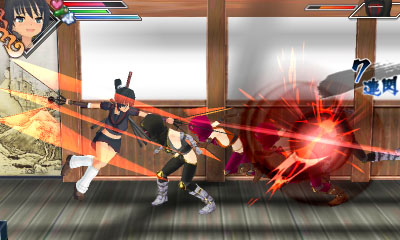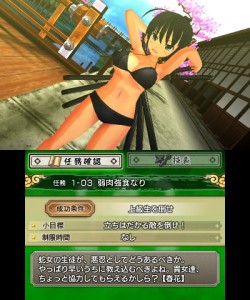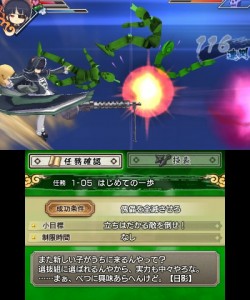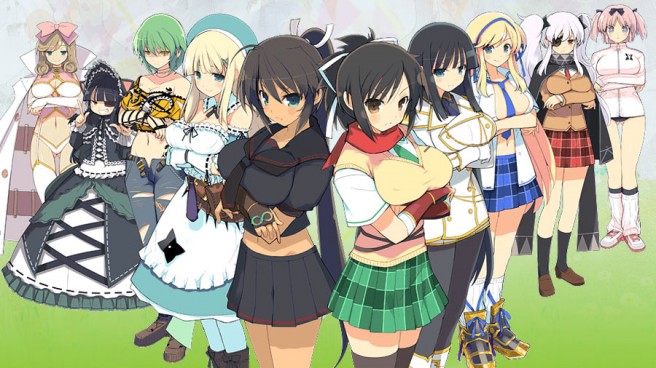[Review] Senran Kagura Burst (3DS)
System: Nintendo 3DS
Release Date: November 15th, 2013 (NA) – Q1 2014 (EU)
Developer: Tamsoft
Publisher: XSEED Games
Price (as of publication): $29.99 (NA)
Author: Austin
“Apparently, within 30 seconds of thinking about a possible game [producer Kenichiro Takaki] decided that one of the things people want to see the most in 3D are breasts.”
Without the existence of the 3DS eShop and a publisher like XSEED, North American audiences would probably never get to fully experience Senran Kagura Burst!. The anime-inspired (directly, in fact: there’s an anime in existence of the same name without the “Burst!” tagline) brawler seems to be on the radar of a handful of folks who probably stumbled upon an eccentric screenshot or video thumbnail that proudly displayed the game’s fascination with large, round breasts. This, after all, is how I was first intrigued.
But another curiosity quickly follows exposure to the game’s aesthetic: Is it actually well-designed, or does its merit hinge solely upon its ability to assail you with large boobs?
It is, a touch regrettably for some, chiefly to do with the boobs.

In its quest to visually showcase a particular part of the female anatomy, Senran Kagura Burst! succeeds. It’s clear from any trailer that the game has a tight visual design and aptly-programmed physics that cooperate swimmingly with the game’s goal of tremendously exaggerating everything to do with boobs– it’s just not totally clear what the point of it all is.
To contextualize: The story of Burst! follows a group of ninja warriors (“shinobi”) who secretly train in the back rooms of a regular school in order to protect the world from the devastating powers of the dark shinobi. All of them (good gals and bad) have exceptionally large and well-proportioned breasts, and they make no effort to hide it: Almost incessantly do the characters joke around about their physical endowment by sexually harassing each other (measured by the standards of reality, anyhow), name-calling (“Calm down, jugs.”), or making frequent reference to the usefulness of having bigger boobs (“I can hide the key in my chest!”). Interestingly, such a strong, unwavering dedication to figuratively pushing the player’s face into virtual bags of flesh has a strong normalizing effect; indeed, churning butter would lose its novelty if you grew up in a society of the Amish, and the world of Senran Kagura is the ultimate Amish society, only instead of churning butter they talk about, touch, and utilize the existence of the female breast.
As you might expect, this is a small bag from which to draw your tricks, and “Look, boobs!” is really about as far as this trick ever goes in an aesthetic sense. Occasionally the game flirts with the idea of taking itself seriously and fleshing out the characters further (which would cast a vaguely interesting light on its visual design, at least), but no sooner does that happen than the game shoves such things into a figurative closet to avoid dealing with the consequences of sincerity. An opportunity only missed due to the game’s length: Were it but two hours long, “Look, boobs!” would not have the chance to lose its novelty and we would be left with an extremely focused and interesting (if only for its novelty) package. The game is closer to 8 or 10 hours, though, and that is far too wide a plane across which to stretch this aesthetic punchline if the gameplay does not prove itself a viable support.

Mirroring the aesthetics, Senran Kagura Burst!’s gameplay is a quality one-trick pony: Regarding the core combat, its controls, the sound and visual effects, and how these things interplay, it’s hard to find any real flaws. The game is certainly a brawler in the truest sense, but it deviates from pure one-button mashing by including a wonderfully satisfying combo-system that has you lifting foes into the air and slamming them back down over and over again, if you’re quick enough to hit the buttons.
Thus, a level begins, enemies appear, you smash them to pieces in the most gratifying sense, more enemies appear, and you smash them to pieces as well; and the cycle repeats for the entire game with few exceptions. Indeed, one level would be absolutely indistinguishable from the rest had they not swapped the background image, and on top of that there is next to no difficulty curve to help you tell them apart, as though the game isn’t certain it wants to be too much of a game at all– or it’s at least confused about what that means for its execution. Sure, the tutorial missions are marginally simpler than those in later chapters, but pour the contents of chapter two and chapter three into a bucket and you’d find it a difficult task to separate them out again. The reason for this dubious uniformity is double-faceted:
1) Every single level (every level) has you starting in a flat arena with artificial barriers, defeating all of the enemies in that arena, and walking a bit to the right before more artificial barriers appear and you fight another group. Every single level, in a gameplay sense, doesn’t even try to differentiate itself from its brethren– if it weren’t so fundamentally satisfying to play this would be impossible to ignore. Regardless, it’s still inexcusable design-wise.
2) No matter what the circumstance, the game seems to use one two groups of enemy character models: Does the mission have anything to do with ninjas? You fight a bunch of faceless ninjas. Does it have to do with anything except ninjas? You fight an amalgamate of wooden snakes, crash-test dummies, and other non-sequiturs. One mission has a man trying to harass one of the shinobis, so you’re tasked with fighting about a hundred snakes/dummies/other things to defeat “him”, even though you never see “him” at all. It would be somewhat charming if the level design weren’t so non-existent. But it is, so it’s not.
Sometimes the game throws in a boss fight that brings out the better in the combat system, but beyond that Burst! offers zero reason to ever feel endangered or to even begin to learn any potential strategies. It wasn’t until halfway through the game that I actually began doing the “shinobi transformations” (your character goes from school clothes to their shinobi clothes and becomes more powerful), and even then it wasn’t out of desperation– it was because I was bored and it looked cool. Indeed, it tries to test you with high-score tables and unlockable accessories, but it lays none of the foundation (varied, passable-quality level design) required to truly achieve that on a fundamental level. It’s a lot of pretty paint on a one-room house.

All of this isn’t to say that the game has no entertainment value whatsoever: Should you see fit to play the game in extremely short bursts over the course of several weeks, it would likely take far longer for its shallow premise to wear thin and you’ll find yourself attached to those moments of visual arousal, textual humor, or satisfactory combat– its value begins to feel much more akin to something like Candy Crush or Bejeweled than a long-form experience. And at that it is at least modestly successful.
But given that the game’s ultimate goal is to give you a either a sense of arousal or to make you chuckle at its absurdity (or, more than likely, both), the designers have stretched things out for far too long for the concept to remain interesting.

I draw a parallel between Senran Kagura Burst!’s abundance of breasts and WayForward’s use of sexualized female characters, Quentin Tarantino’s excessive blood-spattering, or The Wind Waker’s chibi-style: It’s effect is not offensive or smothering after a certain point; it merely accents the experience whenever the designers felt it necessary. The primary failing of Burst! is that once the game loses its novelty (at around the 90-minute mark) there’s nothing left to keep you playing. The designers saw fit to simply repeat the punchline for another six or seven hours, as though they had no idea their joke– while once worth hearing– just wasn’t that funny the fiftieth time around.
Alas, the fundamentals of the game are tactically satisfying, but the game ignores– indeed, ignores— the existence of the abstract concept of “level design” altogether, making for two-hours of adventure stretched over eight or ten. All isn’t lost in the flurry, but it’s far from a perfect execution.


A purchase of Senran Kagura Burst! will rely almost entirely on your enjoyment of its aesthetic. If you are particularly enamored by anime women and basic (but well built) brawler mechanics, then paying full price will likely feel neither like a steal nor a rip-off. Any less than complete adoration for such an artistic style and you’ll want to wait for the price to drop– the game has a few neat tricks that are worth experiencing, but they run dry far too quickly.
Want to participate in more NintendoEverything goodness?
Try our Facebook page!
Or our Twitter page!
